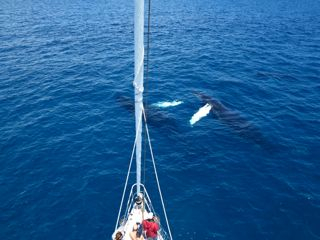Sea Dragon is anchored in what is probably the most remarkable anchorage I have ever visited in over 20 years of sailing. The sea stretches in all directions, dappled with shadows from the clouds under the Caribbean Sun, a rich turquoise field. As I sat on deck this morning after the small boat crew had left I was startled by a burst of air and a splash – a trio of whales surfacing just to port, eye-ing us as they swam by. Watch the horizon in any direction for a few minutes and it is repeatedly broken by a dark torpedo bursting from the water then crashing back in a burst of spray, or stark white fins or tail flukes flapping against the blue of the sea.
65 feet below the keel lies the sand and coral of the Silver Banks, a massive platform about 60 miles north of the Dominican Republic. We’re here with a film crew from the BBC and two Dominican scientists who have dedicated their lives to humpback whales, Oswaldo and Hector. We’re here, of course, because of the whales – every winter, from January to April, the Silver Banks fill with Humpbacks, mating, giving birth, and raising their young. It’s one of the few places in the world where you can easily and safely get in the water and swim with these giants, and have a good chance of finding them.
Find them we have. I grew up in Southern California, off whose coast every year the Gray Whales migrate between Mexico and the Arctic. I grew up used to occasionally seeing a spout from the beach, even went whale watching a few times and saw what I thought were a lot of whales. I had no idea what a lot of whales were. The silver banks are lousy with whales, teeming with whales, infested with whales. Every where you look there seems to be a whale, doing whatever it is that whales do – just breathing as they swim along, splashing and playing, breaching spectacularly. Yesterday as we maneuvered around coral heads, trying to find a nice patch of sand to anchor in, the whales seemed fascinated by Sea Dragon, swimming under and around us, splashing in front of the bow, circling and watching as if trying to discern whether we might be a new, unusual whale who had just arrived.
Now that we’ve stopped moving they seem content to keep their distance, treating us as just another obstacle, showing no worries or cares about proximity but no longer fascinated. I saw more whales just eating breakfast than I have in the last ten years. We’ve been working with Oswaldo and Hector to get the film crew in the water with a Mother and calf, and so far have had mixed success – one pair was interested and playful, but accompanied by a big male who was unamused by the attentions of a 15′ rubber competitor, and showed his displeasure by slapping his tail in our direction and once, spectacularly, breaching three times in rapid succession close between us and his companions. Eventually he became used to our presence and allowed the swimmers in the water, but only for a few minutes at a time, before the whales would move on to wherever they were going, and we would load back into the inflatable and slowly maneuver to find them once again.
Even the mundane is touched by the whales – yesterday while cleaning the bilges Shanley was surprised to hear them singing to her, the noise resonating through Sea Dragon’s steel skin. This is truly one of the most spectacular places I have ever been.
– Captain Eric Loss, S.V. Sea Dragon, March 23, 2015



















